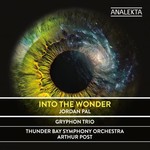
Pal: Into the Wonder
 $35.00
Out of Stock
$35.00
Out of Stock6+ weeks add to cart
JORDAN PAL
Pal: Into the Wonder
Gryphon Trio / Thunder Bay Symphony Orchestra, Arthur Post
[ Analekta / CD ]
Release Date: Friday 23 February 2018
This item is currently out of stock. It may take 6 or more weeks to obtain from when you place your order as this is a specialist product.
Starling: Triple concerto for violin, cello, piano and orchestra
Online videos of flocking starlings, performing breathtaking, whirling aerial displays as they prepare to roost for the winter season, have gone viral. This phenomenon, known as murmuration, is nature in its most fleetingly beautiful and instinctively synchronous form, displaying processes that are poised at the moment of change, to be spontaneously and almost entirely transformed. Not unlike the collective unconscious of a great orchestra breathing together as one, the celestial congregation of starlings and other phenomena are clear testaments to the natural world's capacity to re-inspire.
Amidst the emergent environmental crisis, it might appear that very little energy is spent on conveying to the public the visceral beauty of our ever-changing, ever-renewing natural world. By suggesting through the comparable power of music - and without programmatic depictions - nature's awe-inspiring capabilities, my hope is to inspire a greater appreciation of our environment. This is not an original theme: the suggestion and subtlety of Debussy's La Mer, Sibelius' adoration of the Finnish landscape in musically embodying the moods of nature and the ever-changing seasons, and Messiaen's timeless tribute to the infinite creativity, ingenuity, and vitality of the natural world, as examples. After all, music is possibly the only human endeavor that has the potential to match nature's evanescent splendor.
Starling seeks to capture in musical form the same boundless, breathless, fleeting and visceral qualities indicative of nature. Evocative and startling colours, characters and textures inspire a work that uncovers a deeply intuitive and mystical relationship to nature through sound. Musical techniques, such as aleatoric devices, spontaneous content-driven forms, and the soloists' dynamic interactions with each other and the orchestra, assist in suggesting the intuitively ever-changing, non-linear processes of nature.
Into the Wonder for orchestra
As twilight unveils the faint glimmer of distant stars, a child is born. His mother's heart swells, her breath suspended, joy coalesces with pain. 7,000 light years away, vast stellar nurseries - the remnants of once great celestial giants - are churning gas and dust into new beginnings. Sunrise nears and a hollowed tree, its trunk collapsing under its own weight, returns to the earth. An elderly man takes his last breath. The burgeoning world envelops him.
Spanning three movements, Into the Wonder celebrates the creative will of our universe. Evoking birth and death, creation and destruction, universal interconnectedness and the rapture of love, this piece seeks to capture the mystery, awe and wonder of life. Nature's own great works of art are reminders that we are a part of this magnificent range of possibilities, that we are part of something much greater. This symphony celebrates all that is beautiful.
Bound together by the "connective tissue" of a single musical idée fixe, the three movements of Into the Wonder highlight the ineffability of the universe by means of mysterious sound worlds, colours and textures (aided in part by the addition of the keyboard synthesizer). The first movement muses over the baffling complexity of life and the universe, and their infinite range of possibilities. The middle movement, lyrically fluent and infatuated, explores birth and death, joy and pain, and their inextricable connection to one another. While rejoicing in the magnificence of it all - the fecundity of Mother Earth, the creativity of the universe, the rapture of love, and the insatiable will that drives us forth into the wonder - the final movement fervently thrusts towards the end of the work, cycling back to the mysterious music of the opening movement.
© Jordan Pal